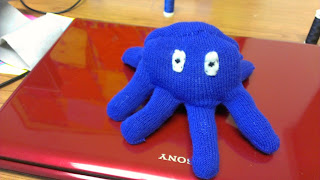Last week, Dr. Kylie Peppler, Verily Tan, and Sophia Bender of IU's Creativity Labs visited the South Fayette School District near Pittsburgh, PA to facilitate e-textiles workshops at the district's STEAM Summer Institute. The district has been working to integrate Art into its teaching of Science, Technology, Engineering, and Math, and, in fact, it will open a new intermediate school (grades 3-5) this fall where STEAM will be the focus. The STEAM Summer Institute introduces South Fayette's teachers to STEAM innovations they can use in their classrooms. Besides e-textiles, this year's Institute featured workshops on Scratch programming, Makey Makey, game design, and flipping the classroom with Classroom Salon.
The district has recently taken an interest in e-textiles; after all, they fit right in with STEAM because they integrate science, technology, computational thinking, and creative crafting. South Fayette hopes to bring e-textiles into all of its fourth-grade classrooms as part of an existing unit on electricity, and to use them throughout the district in places like art classes and after-school programs. First step towards doing all of this? Providing e-textile training to teachers!
The members of the IU Computational Textiles team offered two 2-day workshops with similar content. Over the course of the workshops, educators used alligator clips and LEDs to practice making series and parallel circuits, sewed LEDs onto a quilt square, and learned how to program and sew a final project containing the ProtoSnap - LilyPad Development Simple board. This board contains a LilyPad Simple microcontroller, four sewable LEDs, and a buzzer that can play music notes. Educators learned how to use the Modkit visual programming language to program their LilyPad Simple to control the behavior of their LEDs and make music with the buzzer.
On Monday and Tuesday, we had a very diverse group of attendees, including one fourth-grade teacher, art teachers, technology coordinators, a French teacher, and even some high school students who will act as teachers' assistants during the school year. They brought in t-shirts, bags, hats, and hoodies for their final projects, and left with amazing programmed creations.
On Wednesday and Thursday, attendees included an art teacher and four fourth-grade teachers. The fourth-grade teachers actively planned throughout the session how they could integrate these materials into their classrooms' circuitry curriculum. For their final projects, they sewed their LilyPad onto small cloth bags, and made their LEDs shine in all kinds of beautiful patterns.
The workshop even ended up in the local paper!
Speaking for myself, I've never led a workshop involving the LilyPad before this, and I was astounded by the new possibilities for creativity that programming afforded, things that normally wouldn't seem possible in the medium of textiles. For instance, this bag actually plays the song "Starry, Starry Night" while the stars twinkle:
And here's a patriotic shirt with a flashing firework on it:
The examples of beauty and creativity were endless in these workshops!
We thank Aileen Owens, Director of Technology and Innovation for South Fayette, who coordinated the Institute and was a constant positive force while we were there. Thanks to our wonderful, creative participants for their enthusiasm and cooperation. We also thank the whole district for taking an interest in e-textiles, and we hope to maintain an ongoing partnership to help showcase the potential of these materials in schools!
The district has recently taken an interest in e-textiles; after all, they fit right in with STEAM because they integrate science, technology, computational thinking, and creative crafting. South Fayette hopes to bring e-textiles into all of its fourth-grade classrooms as part of an existing unit on electricity, and to use them throughout the district in places like art classes and after-school programs. First step towards doing all of this? Providing e-textile training to teachers!
The members of the IU Computational Textiles team offered two 2-day workshops with similar content. Over the course of the workshops, educators used alligator clips and LEDs to practice making series and parallel circuits, sewed LEDs onto a quilt square, and learned how to program and sew a final project containing the ProtoSnap - LilyPad Development Simple board. This board contains a LilyPad Simple microcontroller, four sewable LEDs, and a buzzer that can play music notes. Educators learned how to use the Modkit visual programming language to program their LilyPad Simple to control the behavior of their LEDs and make music with the buzzer.
 |
| A teacher's jazzed-up, double-layered quilt square, with 3 LEDs in parallel. |
On Monday and Tuesday, we had a very diverse group of attendees, including one fourth-grade teacher, art teachers, technology coordinators, a French teacher, and even some high school students who will act as teachers' assistants during the school year. They brought in t-shirts, bags, hats, and hoodies for their final projects, and left with amazing programmed creations.
 |
| Teachers from the first workshop discover that the maximum number of LilyPad LEDs that can be lit in parallel by one 3V battery is 24. |
 |
| This fourth-grade teacher told us she planned to add glitter glue to spice up her beautiful LilyPad mini-purse even more. |
Speaking for myself, I've never led a workshop involving the LilyPad before this, and I was astounded by the new possibilities for creativity that programming afforded, things that normally wouldn't seem possible in the medium of textiles. For instance, this bag actually plays the song "Starry, Starry Night" while the stars twinkle:
And here's a patriotic shirt with a flashing firework on it:
The examples of beauty and creativity were endless in these workshops!
We thank Aileen Owens, Director of Technology and Innovation for South Fayette, who coordinated the Institute and was a constant positive force while we were there. Thanks to our wonderful, creative participants for their enthusiasm and cooperation. We also thank the whole district for taking an interest in e-textiles, and we hope to maintain an ongoing partnership to help showcase the potential of these materials in schools!















